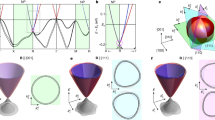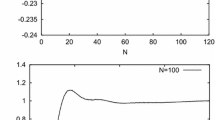Abstract
The de Haas-van Alphen effect in quasi-two-dimensional metals is studied at arbitrary parameters. Oscillations of the chemical potential can substantially change the temperature dependence of harmonic amplitudes that is commonly used to determine the effective electron mass. The processing of the experimental data using the standard Lifshitz-Kosevich formula can therefore lead to substantial errors even in the strong harmonic damping limit. This can explain the difference between the effective electron masses determined from the de Haas-van Alphen effect and the cyclotron resonance measurements. The oscillations of the chemical potential and the deviations from the Lifshitz-Kosevich formula depend on the reservoir density of states that exists in organic metals due to open sheets of the Fermi surface. This dependence can be used to determine the density of electron states on open sheets of the Fermi surface. We present analytical results of the calculations of harmonic amplitudes in some limiting cases that show the importance of the chemical potential oscillations. We also describe a simple algorithm for a numerical calculation of the harmonic amplitudes for arbitrary reservoir density of states, arbitrary warping, spin-splitting, temperature, and Dingle temperature.
Similar content being viewed by others
References
W. J. de Haas and P. M. van Alphen, Commun. Phys. Lab. Univ. Leiden A 212, 215 (1930); Proc. R. Acad. Sci. Amsterdam 33, 1106 (1930).
D. Shoenberg, Magnetic Oscillations in Metals (Cambridge Univ. Press, Cambridge, 1984).
L. M. Lifshitz and A. M. Kosevich, Zh. Éksp. Teor. Fiz. 29, 730 (1956) [Sov. Phys. JETP 2, 636 (1956)].
R. B. Dingle, Proc. R. Soc. London, Ser. A 211, 517 (1952).
T. Ando and Y. Uemura, J. Phys. Soc. Jpn. 36, 959 (1974).
K. B. Efetov and V. G. Marikhin, Phys. Rev. B 40, 12126 (1989).
T. Maniv and I. Vagner, Phys. Rev. B 38, 6301 (1988).
X. C. Xie, Q. P. Li, and S. Das Sarma, Phys. Rev. B 42, 7132 (1990).
P. Grigoriev and I. Vagner, E-print archives, cond-mat/0009409 (2000).
J. Wosnitza, G. W. Crabtree, H. H. Wang, et al., Phys. Rev. Lett. 67, 263 (1991).
S. Hill, Phys. Rev. B 55, 4931 (1997).
N. Harrison, R. Bogaerts, J. Singleton, et al., Phys. Rev. B 54, 9977 (1996).
T. Champel and V. P. Mineev, E-print archives, cond-mat/0006156 (2000).
Author information
Authors and Affiliations
Additional information
From Zhurnal Éksperimental’no\(\overset{\lower0.5em\hbox{$\smash{\scriptscriptstyle\smile}$}}{l} \) i Teoretichesko\(\overset{\lower0.5em\hbox{$\smash{\scriptscriptstyle\smile}$}}{l} \) Fiziki, Vol. 119, No. 6, 2001, pp. 1257–1261.
Original English Text Copyright © 2001 by Grigoriev.
This article was submitted by the author in English.
Rights and permissions
About this article
Cite this article
Grigoriev, P. The influence of the chemical potential oscillations on the de Haas-van Alphen effect in quasi-two-dimensional compounds. J. Exp. Theor. Phys. 92, 1090–1094 (2001). https://doi.org/10.1134/1.1385651
Received:
Issue Date:
DOI: https://doi.org/10.1134/1.1385651




